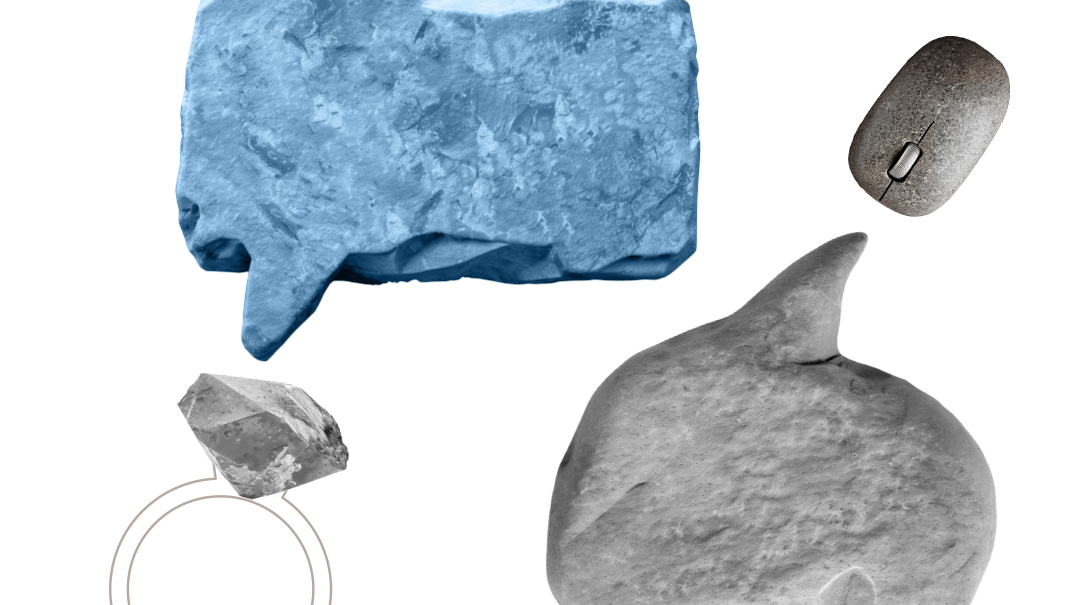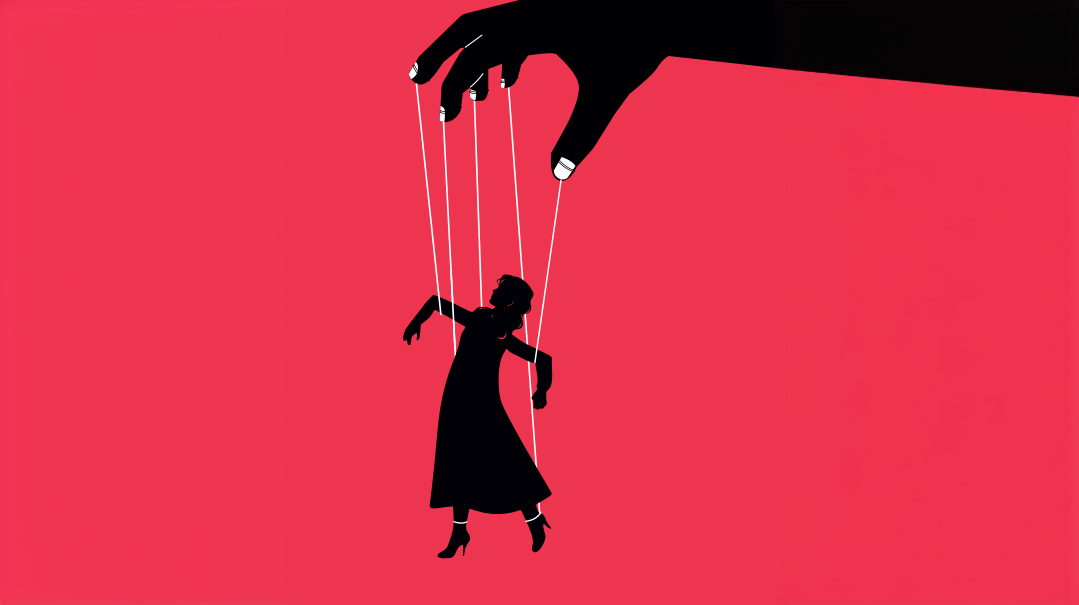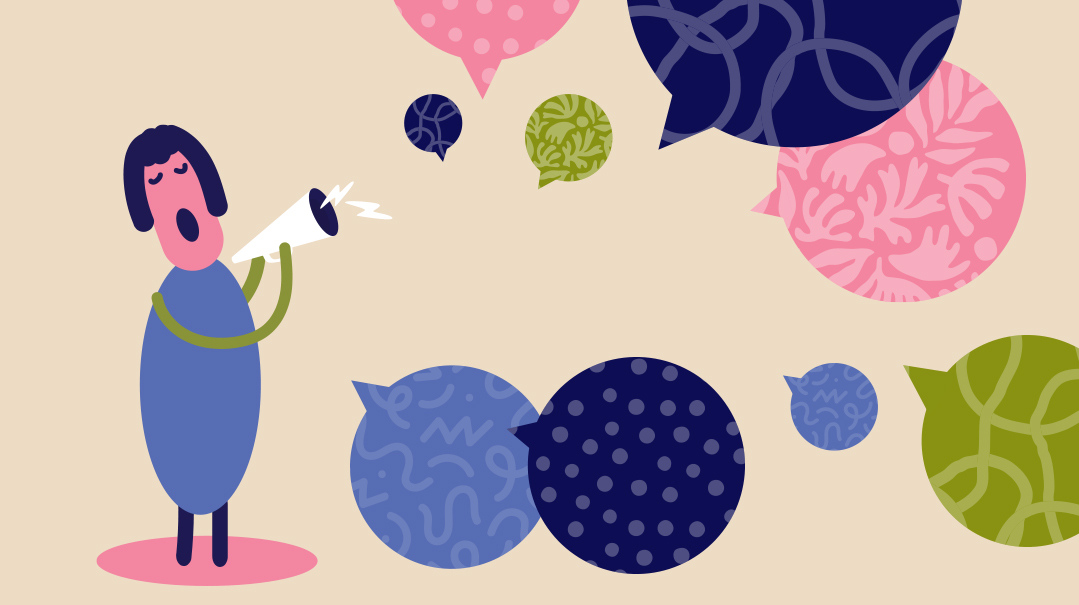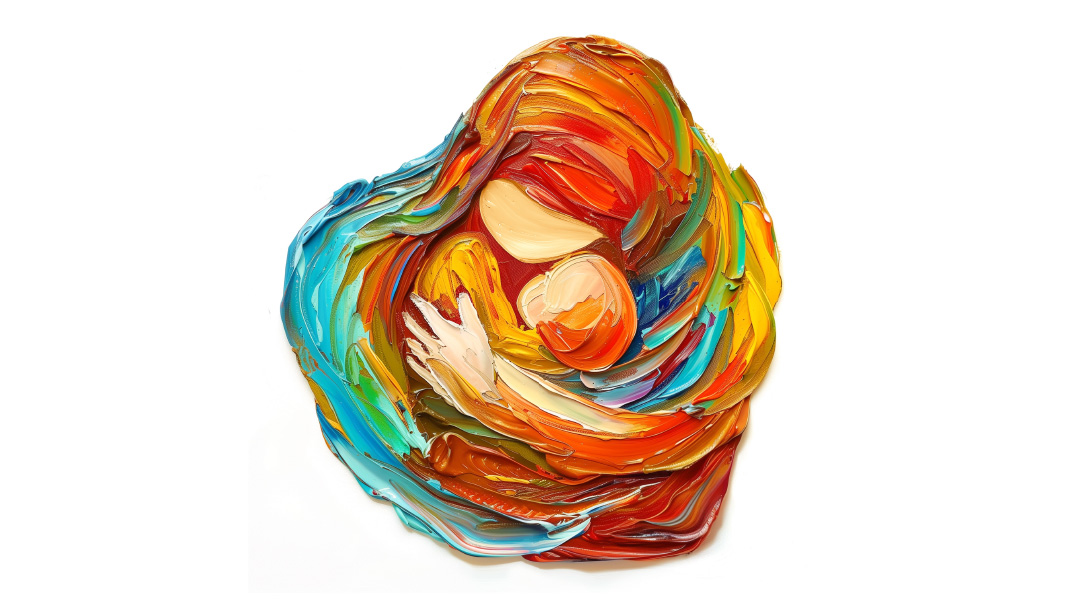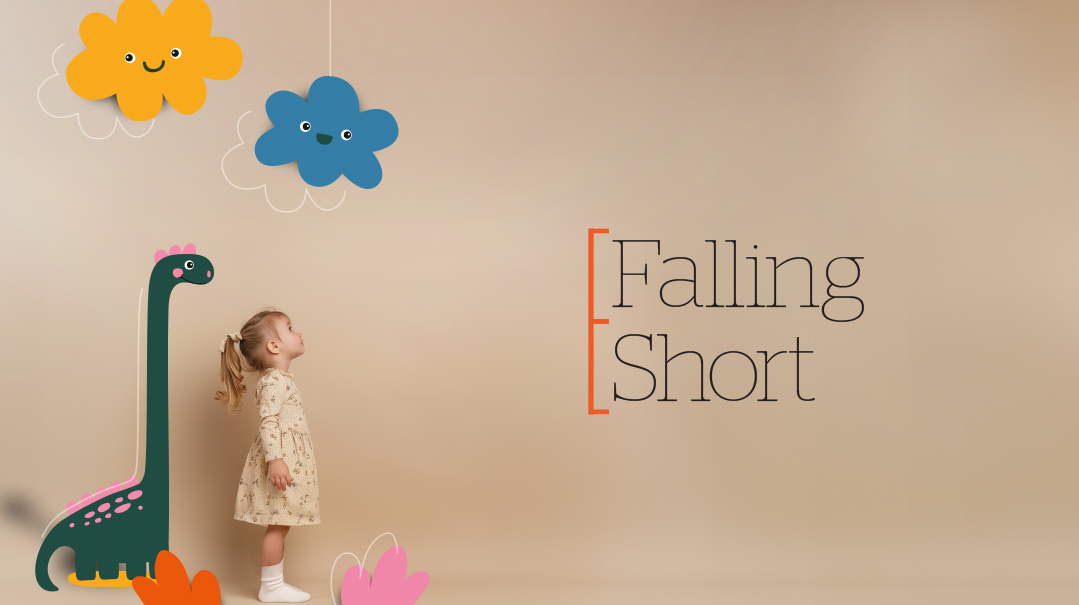Celebration in Color
| July 12, 2022Rus Prupas paints reflections of a life brimming with color
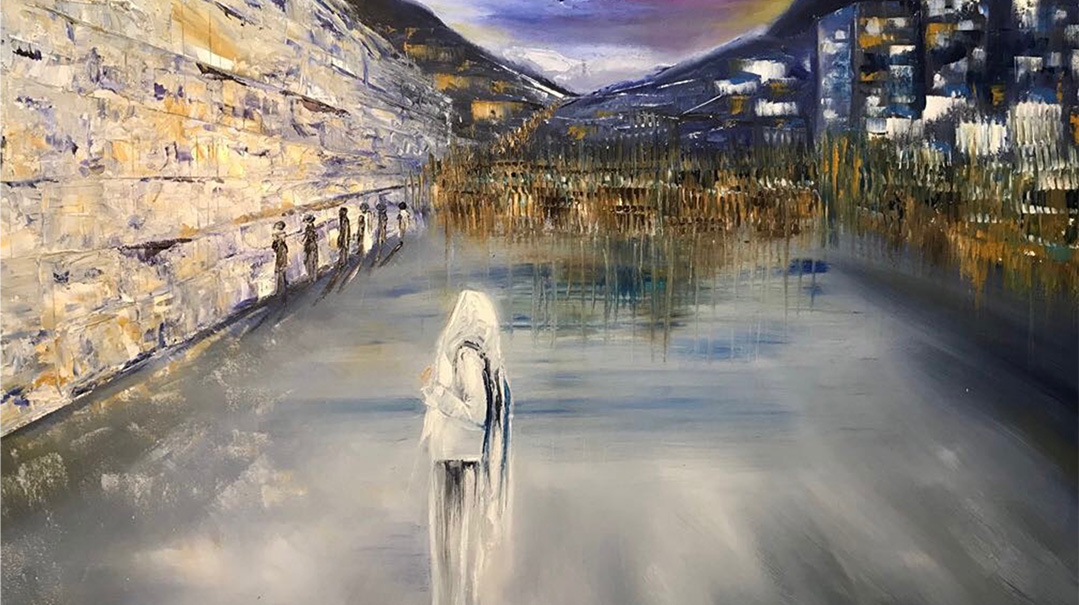
When you look at Rus Prupas’s vibrant artwork it’s hard to believe she only began painting five years ago. But for Rus, mother of 11, former fashion designer, high school teacher, and now acclaimed artist, every stop on the way was part of the journey
“Life is a journey, and Hashem places each person in the right place at exactly the right time, to do what’s best for them at that moment,” Rus says. “And then the time comes when it’s no longer right — and then it’s time to move on.”
Montreal-based artist Rus Prupas’s journey brims with color — both literally and figuratively. She radiates a calm tranquility as she describes her multifaceted career path.
“Hashem gave me a natural creativity and the artistic talent to see things and portray them on paper, but I never thought it could be a profitable profession,” Rus says. “I knew how to draw naturally, and I took a class in portrait painting when I first got married. However, although I did well in the class, we worried that portrait painting wouldn’t be profitable.”
After several years in which Rus was immersed in raising her large family, with art placed on the back burner, Rus turned to clothing manufacturing. She opened her own business, AMICI, which became a popular line of teen clothing. She would draw designs, have them manufactured, and ran the business together with her oldest daughter, Elisheva.
“When my daughter got married, she took over the business, branching out with the name FAME,” Rus says. “It happened over time — first she’d just sell my designs, and then slowly it made more sense for her to take over that part of the business as well.”
Rus states this matter-of-factly; she’s a woman who believes with all her heart that at each stage of her life, she’s placed exactly where she needs to be. “Hashem opens doors, I just follow,” she says.
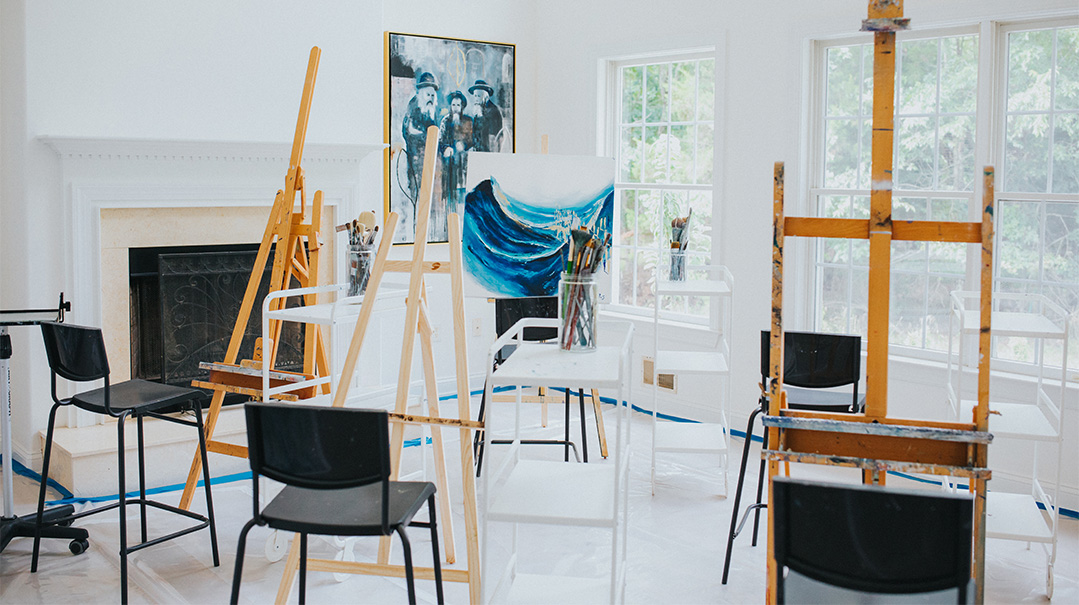
Photo: Yakov Thomas
Finding Art Again
Just about when her daughter took over the business, Rus received a completely unrelated job offer — the principal of a local high school asked if she’d consider teaching. Rus said yes.
“I taught Chumash to tenth and eleventh grades,” she says. “Teaching has creativity, too. A different kind of creativity than art or design, but it’s also a form of expression. I love to give over the fundamentals of Yiddishkeit, how life is all about Hashem, how we can learn from the Avos and take those lessons into our own lives, for the nisyonos that each of us go through.”
The idea of taking up painting again came into Rus’s life as unexpectedly as the teaching did.
“I didn’t plan to paint, I was happy with my job,” Rus says. “But around six years ago, my cousin encouraged me to take a painting class. I went along with it, got myself paints, sketched a picture. When I took the brush in my hand, I felt… wow. I love this. I love this!
“When the class finished, I was so disappointed. I remember thinking, oh no, another whole week until it’s Tuesday again. I was counting the days like a little girl.”
Still, she didn’t yet foresee that her newfound passion for painting would develop into a full-fledged business.
“I’d taken a few painting classes and felt like I wanted to do more than the simple techniques we were being taught,” she says. “So I approached the teacher and asked him to teach me how to paint people in a crowd.”
The teacher was reluctant. He felt that this was a big jump and that a beginner couldn’t possibly have the skills to do it. But Rus persisted.
“I told him, ‘I’m a teacher, and if a girl wants to learn a Ramban, I’ll teach it to her even if she’s only mastered Rashi until now.’ ” she recalls. “But the teacher didn’t like that answer — his method was slow and methodical, while I’m anything but. Sometimes I’ll literally throw the paint on the canvas, I’ll express myself freely… In the end, I left the painting class — it wasn’t a good fit for me.”
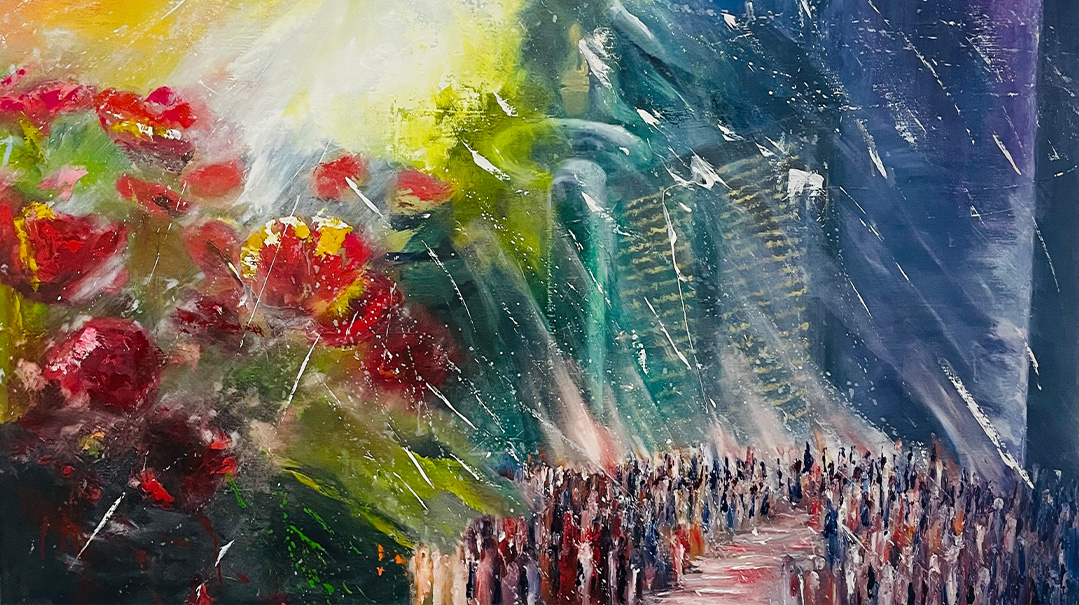
Taking the Leap
Leaving the class was devastating for Rus, who’d found her passion in the paintbrush. But once again, Hashem opened the door for her, this time at an art show, where she met Lubavitcher artist Haim Sherrf.
“I asked him, ‘Will you teach me?’ ” Rus remembers. “He said yes, and I asked how much it would cost. He told me his price was too high, but that he would teach me anyway. I’m grateful to him for believing in my potential as an artist.”
Rus learned by osmosis: She went to Sherrf’s studio, watched him paint, and drank in everything she could about style, technique, medium, and more.
“My style is very different than his, but he never discouraged me — instead, he’d take my work and touch it up to professional level. Eventually I paid him a commission — a percentage of the painting’s selling price. Actually,” she adds with a laugh, “the chesed he did for me ended up pretty lucrative for him.
“The first painting I sold was a milestone. The concept was ‘Ayeles Hashachar,’ and I wanted to portray the power of new beginnings on both a personal and national level. For me, this was a new beginning: my entry into the world of art as a business, not just a hobby.”
Rus’s first art dealer was Chaim Holtzberg from Far Rockaway. He helped her price the painting and sold it from his storefront. From there, things took on a life of their own.
Once she’d reached a certain level, Sherrf told her, “You’re on your own.” It was frightening at first, but now, Rus is grateful. That push was the impetus for her to independently open her own business, and launch The Rus Gallery in earnest.
“But it wasn’t me,” she reiterates. “Hashem opened all the doors. I just followed.”
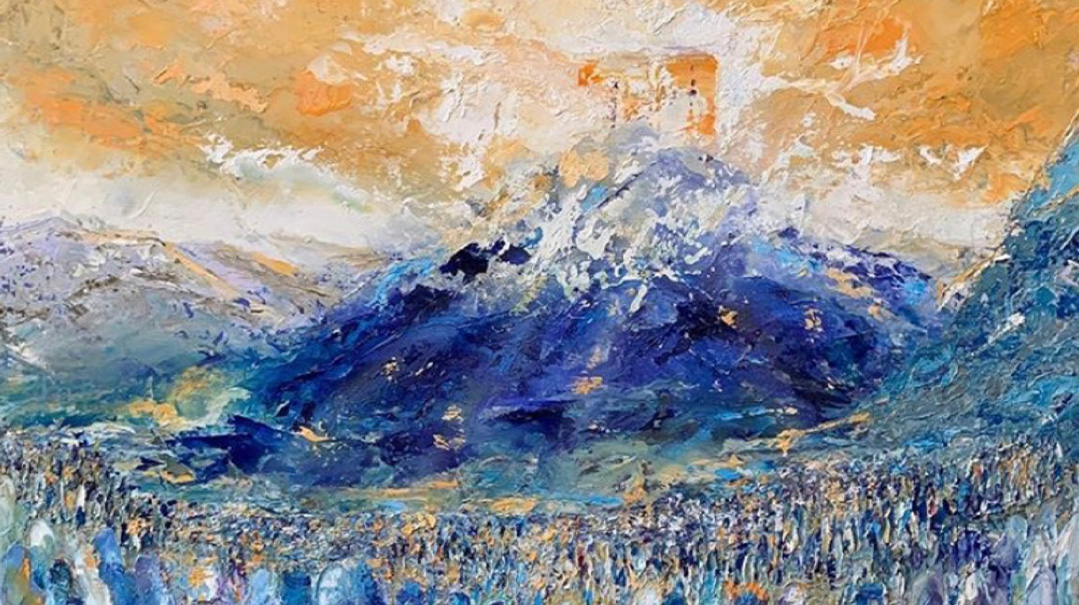
Plugged into Inspiration
Once she started painting, Rus found she couldn’t stop. Eventually, overwhelmed by the sheer volume of commissions she was receiving, she left her teaching job and took two years to paint full-time, developing an impressive portfolio and building her business.
After those two years, though, Rus realized something. “Teaching Torah informs me, it informs who I am. Without it, without giving over and inspiring others, I found it difficult to be inspired, to produce paintings with depth, passion, and emotion. I needed teaching; not as a job, but in order to keep me inspired.
“The tests, grading, and paperwork parts are harder for my creative personality. I have to push myself,” she admits. But she sticks to it because teaching keeps her plugged into inspiration.
One theme that’s particularly prominent in Rus’s work is tefillah, and her favorite painting — the one that hangs in her own living room, right where she davens each morning — is titled Tefillah Moves Worlds, portraying a tallis-clad man absorbed in prayer before the Kosel.
“Tefillah is everything,” Rus says. “Without it, you can’t survive one minute. Whether it’s formal tefillah or just talking to Hashem, it’s the source of everything.”
Rus lives by these values, and that passion is reflected in her work. “From the moment I wake up until the end of the day, I know there’s nothing I can accomplish without Him,” she says. “Hashem is the one who sends ideas, Who guides my paintbrush.”
Rus painted this particular piece layer by layer, developing the final idea as she worked. “When I was finished, I just felt that this one was special,” she says. “I’ve done so many paintings, but this was the one that made me actually trust myself as an artist. It put me in a different space.”
And every day, when she davens, the message continues to inspire her.
The meaning behind each painting is important to Rus, and it excites her when buyers pick up on the nuanced messages she’s poured into the paints.
“A customer once commissioned a painting of a Kosel, but she wanted it huge and very abstract,” Rus says. “I wanted to portray the light and kedushah of Hashem’s presence emanating from the Kosel, so in the middle, I created a light effect. Then I added the people in the foreground, because all that abstract color needed neutralizing. The people are black and silver, to match the decor of the house. It balanced it out.”
When the customer received the painting, she immediately told Rus, “Wow, I love how you’ve shown the curtain lifting and Hashem’s presence shining through.” That was very meaningful feedback, because it was exactly what Rus had had in mind.
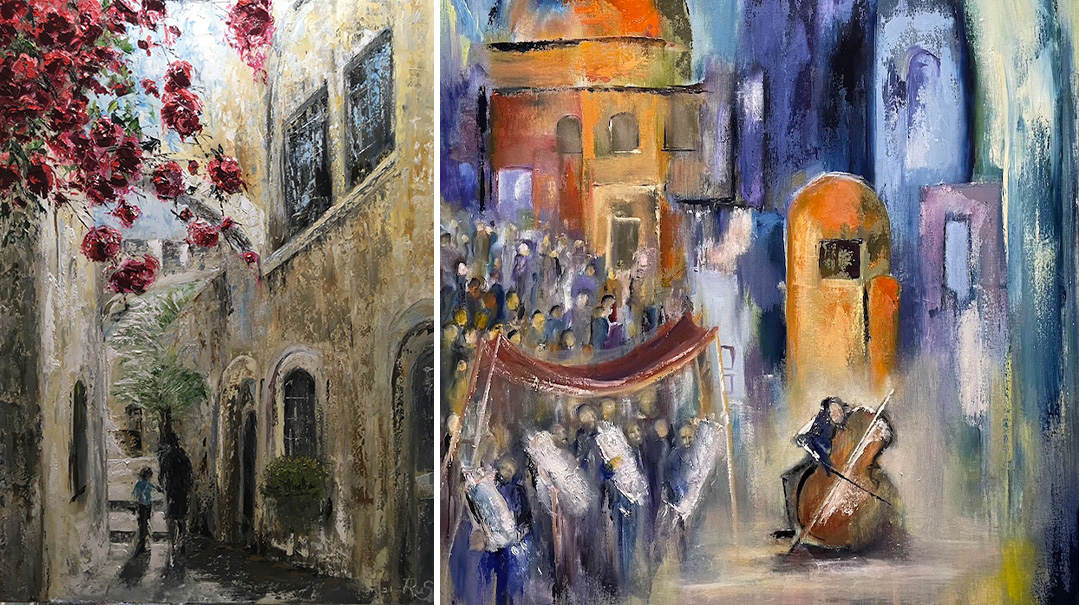
Finding Their Stories
Customers don’t always perceive the deep meaning she attaches to each painting. And that’s fine too.
“I don’t want to impose myself,” Rus says. “When I work, I blend the abstract with the impressionism so that I leave enough of an opening for the viewer to interpret it their own way. Every person should be able to find something of themselves inside it, read their own story.”
One of Rus’s first paintings was of the Kosel. She painted it with the reverent feeling of ‘mah norah hamakom hazeh — how awesome is this place.’ She painted someone standing at the Wall, at a distance, feeling the awe of the moment. A woman who saw that painting told Rus, “I want that painting — it’s exactly what my husband does when he visits the Kosel.”
The woman had found her own story between the paint strokes.
“It’s not about me,” Rus reiterates. “It’s about the viewer. Does it touch them, does it inspire them, does it stir them inside, does it make them happy? If the painting brings them joy, I’m happy, too.”
More than anything, Rus draws her inspiration from davening and from teaching Torah to others.
“When I taught the part of Chumash that deals with the Akeidah, I was struck with the concept that everyone has their ‘Akeidah moment,’ Rus says. “That’s when I created the small painting of the ram, titled Akeidah. It’s in our DNA to overcome these nisyonos in our own lives, and I wanted to create a tangible reminder of it.”
Rus often receives requests to paint Kri’as Yam Suf, and her website contains several portrayals of that seminal moment in Jewish history.
“It’s not just the picture,” she says. “It’s the meaning behind it. Everyone faces their own Kri’as Yam Suf moment, having to be that Nachshon and forge ahead with trust that Hashem will bring you through this journey.”
Rus pauses, then shares one last thought. “I once heard the question asked, why do we call the Next World ‘Olam Haba’ (the world that is coming) and not ‘Olam Sheyavo’ (the world that will come)?
“Because right now, today, there’s Olam Haba as well — it’s just not revealed to us. We can’t see it. When Mashiach comes, the curtains will be stripped away, and we’ll be able to see the kedushah that was present all along.”
Inspired by this idea, Rus painted a man davening behind a thick, textured wall. Although he can’t see it, fading through the heavy wall are the pillars of the Azarah.
“Geulah is here — it’s just not revealed to us yet,” she says. “We think we’re so far away, so distant, behind a thick wall — but it’s all an illusion.”
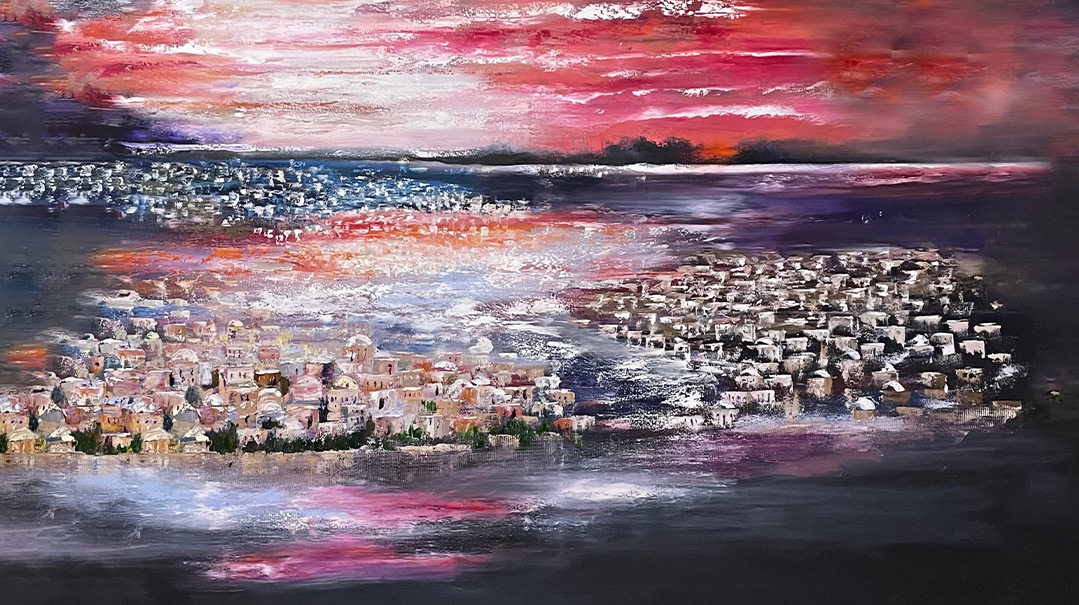
Moving On
Rus currently juggles her painting, teaching, and the technical parts of running her business.
“People say it’s a pity I didn’t start painting earlier, but I don’t think so,” she shares. “It came at the perfect time, just when my youngest is already a teenager, and I don’t have little kids in the house anymore. Painting is absorbing; I can lose track of the time and paint for eight hours straight. It wouldn’t have been the right thing for me earlier.”
There’s further change taking place: the Prupases recently moved from Montreal to Lakewood, where several of their married children live.
“We saw real nissim selling our house here and finding one in Lakewood,” Rus says.
In Lakewood, Rus plans to continue inspiring through her artwork. Her daughter runs Zohara art gallery, and Rus will sell her paintings there, as well as take commissions via her website. She also hopes to teach art and help women unearth their latent talents and creativity.
“Someone told me recently, ‘Oh, Rus, when you set your mind to something, you just do it.’ But it’s not really the way it happens. I sit back and see where Hashem takes me. It’s all Him.”
And that’s the secret to Rus’s paintings. Layer by layer, every shade and hue combines to tear down the barriers and bring us closer to the Source of it all.
Celebrating Jewish Life
The Rus Gallery is a treasure trove of deeply emotive and multifaceted images, a collection that’s a deep dive into everything that’s authentic and meaningful about Jewish life.
“Through my art, I can share my love for tefillah, Yerushalayim, and avodas Hashem,” Rus says. “It’s how I celebrate being a Yid, and how lucky we are to live in a time when we can openly and freely serve Hashem.”
Rus’s paintings vary in themes, from Sarah’s tent to nisuch hamayim to dreaming of Mashiach — a melding of past, present, and future into one multihued display, the heartbeat of Jewish life. As rich in passion and meaning as they are saturated in vivid color, Rus says that Torah and tefillah inspire her work.
“I have to live on a different plane; a plane where I’m open to becoming inspired,” she says. “But of course, I hit dry spells sometimes. So that’s when I’ll turn to more technical and less creative parts of the process.”
Rus keeps a “bank of ideas” on her computer, with plans of designs that she’s been inspired to create. During a dry spell, she’ll print and pull out these ideas, or do some abstract painting work until the creative spark ignites again.
“Paintings stir inside me,” she says. “I have no other words for it — Hashem places them in my heart.”
Rus uses Pixelmator to form the sketches for her painting, combining images to get an idea of what she’s going to create. She works on several painting projects simultaneously, so there’s always something fresh to work on if the work becomes tedious.
Rus works primarily with oil paints. “Acrylic and I are not great friends,” she says wryly. “I love oils, though, the smell, the texture, the way it spreads on the canvas. Many artists use acrylics as a base and add oil for the textured surface layer, but I do the entire thing in oils, layer by layer.”
Because she works on several paintings at once, it’s hard for her to give a timeline to the painting process.
“When I’m inspired, it’s a lot quicker,” she says. “When I’m not feeling the message as strongly, it takes time to draw it out of myself.”
How does Rus know when a painting is finished?
“It’s a feeling I get when I paint that last stroke,” she says. “It’s almost magical. I simply feel — this is done. This is it. Thank you, Hashem!”
(Originally featured in Family First, Issue 801)
Oops! We could not locate your form.

